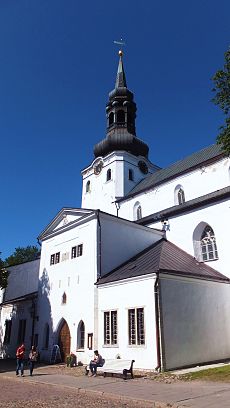St Mary's Cathedral, Tallinn
| St Mary's Cathedral | |
|---|---|
| The Cathedral Church of Saint Mary | |
| Toomkirik | |
 |
|
| 59°26′14″N 24°44′20″E / 59.4371°N 24.7390°ECoordinates: 59°26′14″N 24°44′20″E / 59.4371°N 24.7390°E | |
| Country | Estonia |
| Denomination | Estonian Evangelical Lutheran Church |
| Previous denomination | Roman Catholic |
| Website | Cathedral website |
| History | |
| Founded | 1240 |
| Founder(s) | Danes |
| Dedication | Blessed Virgin Mary |
| Architecture | |
| Status | Active |
| Functional status | Cathedral |
| Style | Gothic |
| Clergy | |
| Archbishop | Urmas Viilma |
| Rector | Arho Tuhkru |
St Mary's Cathedral, Tallinn (Estonian: Toomkirik, full name: Tallinna Neitsi Maarja Piiskoplik Toomkirik, German: Ritter- und Domkirche, English: The Cathedral of Saint Mary the Virgin in Tallinn, also known as Dome Church) is a cathedral church located on Toompea Hill in Tallinn, Estonia. Originally established by Danes in the 13th century, it is the oldest church in Tallinn and mainland Estonia. It is also the only building in Toompea which survived a 17th-century fire.
Originally a Roman Catholic cathedral, it became Lutheran in 1561 and now belongs to the Estonian Evangelical Lutheran Church. It is the seat of the Archbishop of Tallinn, the spiritual leader of the Estonian Evangelical Lutheran Church, and chairman of that church's governing synod.
The first church was made of wood most likely already and built by 1219, when the Danes invaded Tallinn. In 1229, when the Dominican monks arrived, they started building a stone church replacing the old wooden one. The monks were killed in a conflict between the Knights of the Sword and vassals supporting the Pope’s legate in 1233 and the church was thus desecrated. A letter asking permission to consecrate it anew was sent to Rome in 1233 and this is the first record of the church’s existence.
The Dominicans couldn’t finish the building. Actually, they built only the base walls. The building was completed in 1240 and it was a one-aisled building with a rectangular chancel. In 1240, it was also named cathedral and consecrated in honour of Virgin Mary. In the beginning of the 14th century, reconstruction of the church began. The church was made bigger. The reconstruction began with building a new chancel. At about the same time, the new vestry was built.
The enlargement of the one-aisled building to a three-aisled building began in the 1330s. The construction work, however, lasted almost 100 years. The new longitudinal part of the church, 29 meters long, built by following the principles of basilica, was completed in the 1430s. The nave’s rectangular pillars had been completed in the second half of the 14th century, though.
...
Wikipedia

